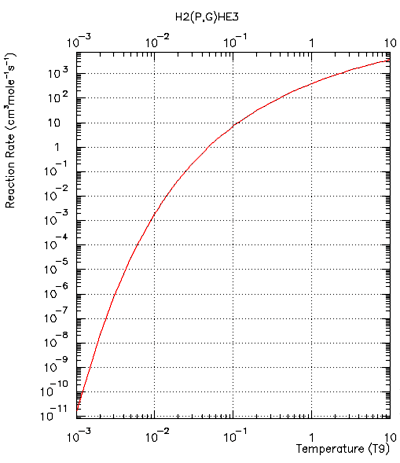[Note: the C&F value /NAv = 6.66×10−39; unless the "new measurements... and other corrections" mentioned in H&K have been applied in the C&F value, it is not clear to me where the 5% difference comes from...]

Plot from C&F
| 1H + 1H | → | 2H + e+ + νe | ||||||
| 2H + 1H | → | 3He + γ | ||||||
| PP-I:x | 3He + 3He | → | 4He + 21H | |||||
| PP-II:x | 3He + 4He | → | 7Be + γ | |||||
| 7Be + e− | → | 7Li + νe + γ | ||||||
| 7Li + 1H | → | 24He | ||||||
| PP-III:x | 7Be + 1H | → | 8B + γ | |||||
| 8B → 8Be + e+ + νe | ||||||||
| 8Be → 24He | ||||||||
Because the decay of a proton into a neutron, positron, and neutrino is so unlikely in the first reaction, this reaction sets the rate. H&K quote Caughlan and Fowler (1988) [note: C&F tabulate cm3 mole−1 s−1]:
<σv>pp = 6.34×10−39
T9−2/3
(1 + 0.123T91/3 + 1.09T92/3 +
0.938T9) e−3.380T9−1/3
cm3 s−1.
[Note: the C&F value /NAv = 6.66×10−39; unless the
"new measurements... and other corrections" mentioned in H&K have been applied in the C&F
value, it is not clear to me where the 5% difference comes from...]

Plot from C&F
The rate becomes (without the correction terms, and remembering to divide by 2 to avoid double-counting pairs of identical reactants)
Rpp = 1.15×109 T9−2/3
X 2ρ 2
e−3.380T9−1/3
cm−3 s−1
[Note: I think H&K neglected to divide by Ap2, which reduces the
coefficient to 1.13×109].
The temperature power law exponent νpp = 11.3T6−1/3 − 2/3, ≈ 4 in the solar core.
The Q-value of the reactions available for thermal energy does depend on which
chain is in effect, because the different neutrinos carry of different amounts of energy.
From Fowler, et al. (1975) by way of H&K:
Qeff = 13.116 [1 + 1.412×108 (1/X − 1)
e−4.998T9−1/3] MeV.
[Note: Q is the yield per reaction, in this case involving 2 protons or half
the final 4He nucleus.
The BE per nucleon for 4He ≈ 7.1, so 14.2−13.1=1.1 MeV is carried
off by the neutrinos.]
Without the correction terms,
εpp ≈ 2.4×104 X 2ρ
T9−2/3
e−3.380T9−1/3
erg g−1 s−1.
2. Deuterium burning
H&K discuss the production of 2H in the Big Bang via the reaction p + n → 2H + γ; see the nucleosynthesis pages. They do not discuss the burning of 2H in pre-main sequence and low-mass stars.
The C&F formula for <σv> 2H(p,γ)3He is:
<σv> 2H(p,γ)3He =
3.72×10−21
T9−2/3
(1 + 0.112T91/3 + 3.38T92/3 +
2.65T9) e−3.720T9−1/3
cm3 s−1.

For the low temperatures of interest, the correction terms may be neglected and the
reaction rate becomes
R 2H(p,γ)3He =
6.75×1026 T9−2/3
XDXp ρ 2
e−3.720T9−1/3
cm−3 s−1,
and the energy generation is
ε 2H(p,γ)3He =
1.5×1021 T9−2/3
XDXp ρ
e−3.720T9−1/3
erg g−1 s−1.
The cross section is so large that deuterium burning becomes significant at
temperatures of order 600,000 K in stellar interiors.
We may calculate the half-life of deuterium atoms against proton capture from
τ = n /R,
τ D = 4.5×10−4
T92/3
(Xp ρ)−1
e3.720T9−1/3 s,
≈ 1.5×106 (Xp ρ)−1 years
at T9 = 0.6×10−3.
The Jovian deuterium mass fraction XD ≈ (3.1±0.4)×10−5 ( Lellouch, et al. 2001, A&A 370, 610, assuming Xp = 0.71). Abundances determined for the local ISM and absorption systems in front of distant galaxies show a wide scatter around this value, in part because deuterium is very difficult to see in the wings of hydrogen features, and in part because there are chemical processes which may deplete one isotope relative to another. The value is consistent with the small fractional contribution of baryonic matter to the cosmic Ω.
ISM compilation from Ferlet, et al. (proceedings of the Science with the Hubble Space Telescope--II workshop, held in Paris, December 4-8, 1995).

Figure: Measurements of the D/H ratio in the local ISM.
The left hand-side box collects data obtained toward hot stars,
while the right hand-side one shows cool stars observations.
The x-axis has no physical significance, and merely labels the different stars.
Data points next to each other, within less than 1 x-axis unit,
correspond to the same target star. The open circle represents
the Linsky et al. (1995) measurement using HST toward Capella.
All other data points come from Copernicus or IUE observations.